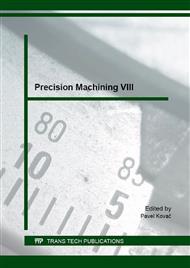[1]
J. Brychta, R. Cep, M. Sadilek, L. Petrikovska, J. Novakova, Nove smery v progresivnim obrabeni, VSB, Ostrava, 2007, p.251.
Google Scholar
[2]
P. Byrne, Turning, milling and grinding processes. London, Arnold, (1996).
Google Scholar
[3]
F. Holesovsky, M. Novak, Grinding and its influence to ground surface durability, Proceedings of International Conference on Advances in Materials and Processing Technologies, Paris. Publisher: Amer INST Physics, Melville, NY, USA. (2010).
Google Scholar
[4]
J. Jersak, Vliv dynamickeho vyvazeni brousiciho kotouce na drsnost povrchu obrobenych soucasti, Strojirenská technologie, Vol. 17, No. 1, 2, 2012, pp.27-33.
Google Scholar
[5]
D. Kalincova, Skusanie mechanickych vlastnosti materialov - prehlad meracich metod a zariadeni, Proceedings Zvysovani efektivnosti vzdelavacieho procesu prostrednictvom inovacných prostriedkov, TU vo Zvolene, Zvolen., SK, 2010, pp.13-26.
Google Scholar
[6]
K. Kocman, Optimalizace dokoncovacich operaci vyrobnich procesu, Strojirenska technologie, Vol. 17, No. 3, 2012, pp.164-169.
Google Scholar
[7]
K. Kouril, R. Cep, A. Janasek, A. Kriz, D. Stancekova, Surface integrity at reaming operation by MT3 head. Manufacturing Technology, Vol. 14, No. 2, 2014, pp.193-199.
DOI: 10.21062/ujep/x.2014/a/1213-2489/mt/14/2/193
Google Scholar
[8]
J. Kundrak, V. Fedorovich, A. Markopoulos, I. Pyzhov, N. Kryukova, Improvements of the Dressing Process of Super Abrasive Diamond Grinding Wheels, Manufacturing Technology, Vol. 14, No. 4, 2014, pp.545-554.
DOI: 10.21062/ujep/x.2014/a/1213-2489/mt/14/4/545
Google Scholar
[9]
J. N. Maslov, Teorie brouseni kovu, SNTL, Praha, 1979, 284 p.
Google Scholar
[10]
M. Novak, Surface quality of hardened steels after grinding. Manufacturing Technology, Vol. 11, No. 11, UJEP, 2011, pp.55-59.
DOI: 10.21062/ujep/x.2011/a/1213-2489/mt/11/1/55
Google Scholar
[11]
M. Novak, Surfaces with high precision of roughness after grinding. Manufacturing Technology, Vol. 12, No. 13, 2012, pp.66-70.
DOI: 10.21062/ujep/x.2012/a/1213-2489/mt/12/1/66
Google Scholar
[12]
M. Novak, F. Holesovsky, Studium integrity brouseneho povrchu [online]. [cit. 2014-2-28]. Available at www: http: /www. fvt. tuke. sk/journal/pdf08/2-str-11-13. pdf.
Google Scholar
[13]
N. Novak, H. Kasuga, H. Ohmori, Differences at the Surface Roughness by the ELID and Grinding Technology. Manufacturing Technology, Vol. 13, No. 2, 2013, pp.210-215.
DOI: 10.21062/ujep/x.2013/a/1213-2489/mt/13/2/210
Google Scholar
[14]
K. Osicka, Prumerna aritmeticka uchylka drsnosti povrchu - statisticke vyhodnoceni plochy, Strojirenska technologie. Vol. 14, No. 1, 2009, pp.30-32.
Google Scholar
[15]
L. Rokyta, I. Lukovics, Vyzkum vlivu pomeru brusiv na jakost povrchu pri brouseni, Strojirenska technologie, Vol. 17, No. 1, 2, Ústí nad Labem, 2012, pp.93-95.
Google Scholar
[16]
M. Tavodová, The surface quality of materials after cutting by abrasive water jet evaluated by selected methods. Manufacturing technology: journal for science, research and production. Vol. 13, No. 2, 2013, pp.236-241.
DOI: 10.21062/ujep/x.2013/a/1213-2489/mt/13/2/236
Google Scholar
[17]
J. Valicek, J. Rusnak, M. Müller, P. Hrabe, M. Kadnar, S. Hloch, M. Kusnerova, Geometricke aspekty drsnosti pov rchu klasickych a netradicnich technologii. Jemna mechanika a optika, Vol. 53, No. 9, 2008, pp.249-253.
Google Scholar


